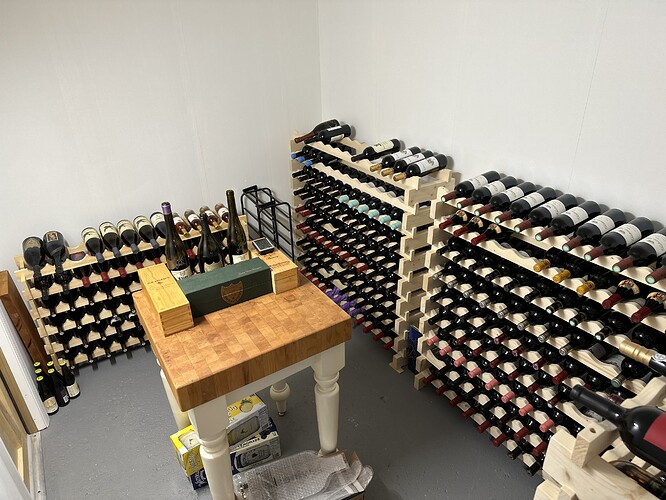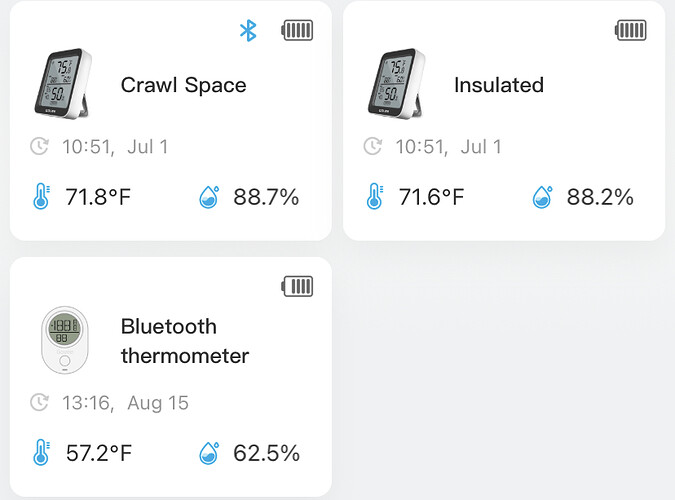Here’s a picture of how it came out before I put all the racks in. Painted the floor (concrete slab) with masonry paint and got pine racks from Amazon.
72 will not ruin the wine, but will result in faster aging that will be noticeable even in 5 years compared to cooler storage. I’ve definitely experienced that with some bottles I had kept for a while in more ambient conditions before I got a proper cellar. Whether you like that or not depends on the wine and your drinking preferences.
This is really interesting to me does it act as insulation, vaper protector, and “in essence” sheet rock?
72 year round? Or is that only the summer temp? I have an “overflow” area in my basement where I keep the cellar defenders and stuff I want to drink relatively soon, and it touches 70 in the summer, but only for about 8 weeks or so. Most of the rest of the year slowly swings from 54-65. It’s under 60 2/3 of the year. Even stuff that has “accidentally” ended up in that area for 10 years has still been essentially unaffected. I’ve even done control samples with blinded tastings of identical wines both in the 53-55 degree wine cellar and the overflow space.
Effectively, yes.
I had a section of my basement that was an old canning cellar to store supplies over the winter. It was already pretty stable in terms of temps but I wanted something a bit better without spending a ton for a fancy cellar. Temps top out around where they are now and get in to the high 50s and low 60s in cooler seasons.
Good enough for me but I don’t see myself holding much over 15 years and my capacity is limited to around 500 bottles or so.
If I really up my game, I have space to install a chilling unit so that’s always an options to supplement in summer.
Although if you wanted to anchor something to the wall you’d have to use masonry screws and go through the insulation. You can’t hang or mount anything to the foam itself.
That was probably apparent already but that’s the one big difference from sheetrock.
My storage room has no AC so does get up to that temp pretty regularly during the summer.
The rigid insulation may be the way to go then. I can even have my contractor build a frame for it and use it like a wine closet.
So far I’m not seeing a big difference between the temp probes I set up in the crawl space. The insulated one is sitting in an inch thick foam cooler. That may not be sufficient to make a difference.
This is my experience as well. Most wines will be fine, a few you may notice a difference. Some might even be better lol.
But I assume this is the worst case, and only during the warmest parts of summer. The rest of the year should be considerably cooler. So I’d say just forge ahead with your plan.
3-5 Years!? I think you could store those bottles above your refrigerator and be OK.
In addition to the daily drinkers < $50, what I predict will happen is that you also use the space for
(1) wines pulled from offsite you plan to drink reasonably soon
(2) mature wines bought at retail or auction that you plan to drink reasonably soon
(3) wine that arrived or you bought and haven’t taken into offsite storage yet
And that should be completely fine as well.
It would be fun learning for yourself and for us if you ran an experiment — put a couple bottles each of the same $50ish ageworthy red into each place, try them blind at age 3 and age 5. See if there is a difference and if so, which one is better. I’d love to hear the results.
I have read that higher long term temp, as well as aging the wine quicker, may accentuate some faults a wine (or bottle) might have.
Def agree with comments here to focus on not going over 75 , and relatively constant temp, and reasonable humidity (unless you like extracting crumbly corks).
r10 does not equate with 1" of insulation. i can’t think of any material hitting r8+ at 1"
Thats what I was thinking. A short cut to not use sheet rock or vaper barrier. Simply put up ridged insulations, cut a hole for a cooler, paint and job done! Very interesting.
I wouldn’t do that.
When I first started buying “nicer” wines (which at the time were still fairly ordinary california red wines), I built a small storage rack that I put in the closet where I access the crawl space under my house. I figured that was the coolest space I had. Any bottle in there for 2-3 years was definitely more developed than it would have been stored at 55-60. They were drinkable, but not as good as they should have been. Shortly after that I rented my first locker in a commercially storage facility.
While I would not worry about 72, I’d be worried if it had already reached 72. I have a passive cellar (southern NY), and my warmest temps (about 70-72) are in Sept. It’s probably 66 now. NE corner, no direct sun, thck stone walls, insulated walls If you are using the ground as a heat sink the end of summer is the hottest period .
Correct R10 would be 2”.
July is the hottest month here but I’m not sure about the ground temps. I irrigate the lawn 3 days a week and daily in September, does that help with the ground temps?
The issue isn’t the hottest month, it’s the length of time the average mean air temperature is well above the deep soil temp. Cellar (or basement or crawl space) creeps up gradually and cumulatively . July and Aug are hottest months here, but my cellar temps are higher in Sept than July,
I’d be shocked if irrigating lawn cooled a crawlspace.

